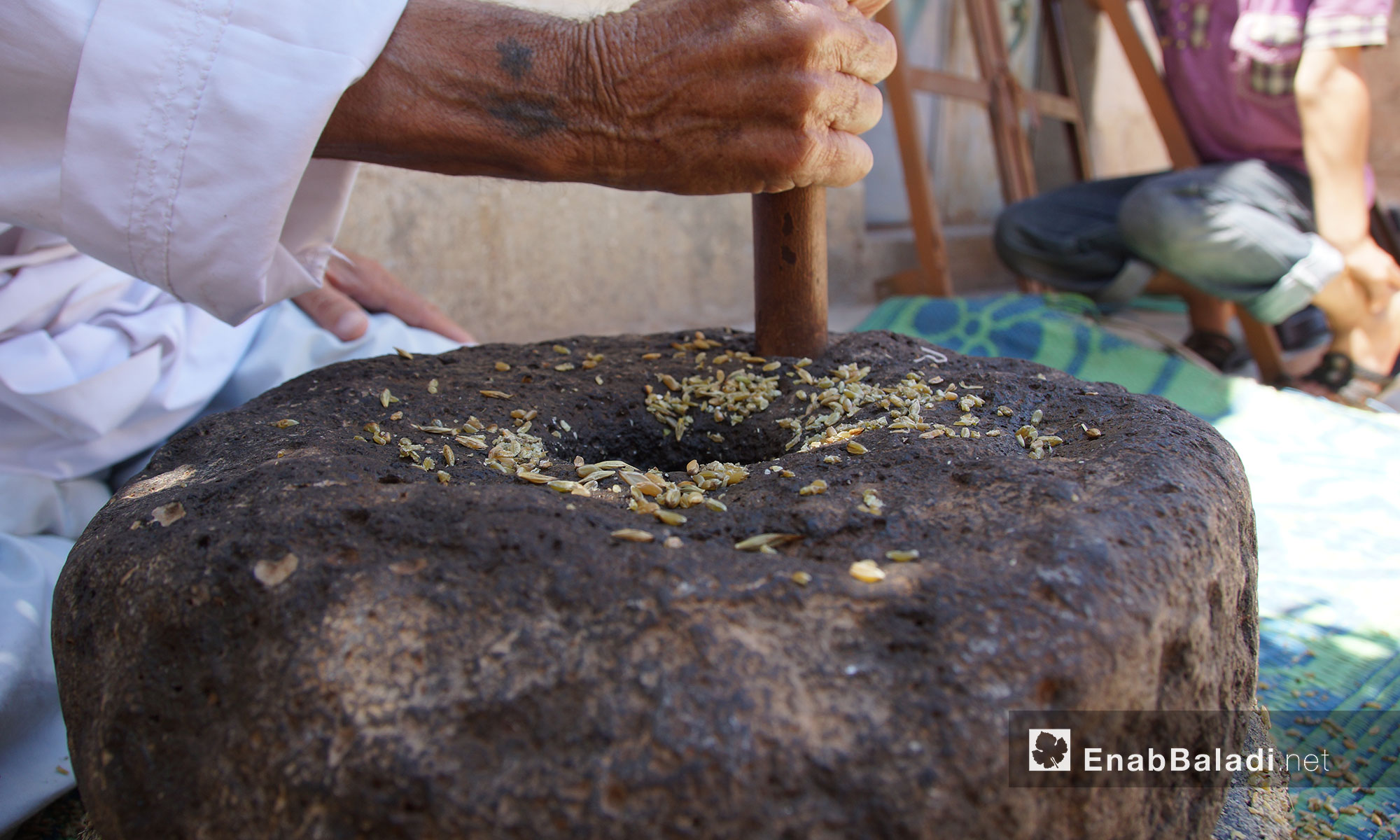



Idlib – Huda al-Kulaib
Nabila al-Salmani wakes up in the morning to start grinding boiled and dried wheat using a millstone to prepare lunch for her big family in al-Fatirah village in northern Idlib governorate.
The woman, who is in her fifties, told Enab Baladi, “In the past, our mothers and grandmothers used mills to prepare the flour from which we would make the ‘Tandoor’ bread, which is a traditional bread baked in a clay oven and has a delicious and lovely flavor.”
The millstone is not a seasonal tool, as some people think. In the past, it was present in every home, and “our grandmothers and mothers could not do without it, but with development and modernity, nothing remained of it except what is left in some villages,” the woman added.
With the millstone at home, which al-Salmani had always kept with scrap and discarded tools, she no longer needed to commute to neighboring towns and cities for the grain milling process.
Millstones and many traditional heritage features have recently returned to work in a number of towns in the Jabal al-Zawiya region and remote villages as a result of the absence of modern mills, the power cuts in those villages and towns, and the displacement of a large number of people from these areas.
The region is located on the contact line with the Syrian regime forces, and it was previously subjected to attacks with the aim of controlling it with Russian support until the map of control was imposed in early 2020, but the area is still subjected to intermittent bombardment, the pace of which increases with every talk about future military operations.
A millstone is a primitive machine made of coarse, heavy stone used for crushing and grinding grains. It is two round stones that are installed one above the other, and the lower of them is fixed, while the upper stone moves around a wooden or metal axis called the pole of the mill, whose base is fixed at the bottom of the lower stone.
When the millstone rotates, it passes over the grains of wheat or barley that are placed from a small circular opening in the center of the upper stone. These grains break little by little as the millstone rotates on them until they become fine flour suitable for making bread or other food uses.
Elderly Khadija al-Humaidi no longer feels weary and bored after returning to work on the millstones in her village of Blaine in Jabal Al-Zawiya after the mills became a “magnet” for the women of the village looking for a means of milling after the absence of market appearances and the loss of modern milling services from the small village, which most of its residents fled out of it, except for some low-income families who cannot find a way to move and live in safer places due to their modest conditions.
Al-Humaidi said that she returned to using the millstone more than two years ago when she was forced to grind quantities of grain and did not find anyone to grind it after the displacement of most of the residents of the village, which was badly damaged as a result of the continuous bombardment.
The millstone became the only resort and alternative solution to grinding grains not only for al-Humaidi but for everyone who stayed in the village and did not leave it.
“During our meeting to work on the millstone, we do not remember the fatigue, we exchange the millstone from hand to hand, and we share the work with those who remain in the village.”
Al-Humaidi adds, “We exchange conversations, worries, and pain, and complain about a time that separated us from our loved ones and children and brought us back to the age of using the millstone, where familiarity and good company were.”
As for Amoun al-Farid, 40, from the village of Mara’an, she sings folkloric songs whenever she goes to her neighbor’s house to grind some grains on her own.
She told Enab Baladi, “We gather around the mill and sing some folk songs that make us forget our worries and pain, at a time when everything beautiful in our lives came to an end.”
Heading to the mill is not the region’s biggest concern, as they fear that the wheat itself will be cut off or that prices will rise beyond their ability, with purchasing power declining and 90 percent of the general population in Syria below the poverty line, according to UN estimates.
The area of wheat-planted land in Idlib reached 74,845 dunums in 2022, according to the Syrian Salvation Government (SSG). Such an area is not sufficient to produce a third of the wheat needs of the northern Syrian regions.
The local governing body has set wheat prices for purchase from farmers at numbers ranging between 430 and 450 US dollars per ton according to quality, percentage of impurities, and if the wheat is hard or soft.
if you think the article contain wrong information or you have additional details Send Correction